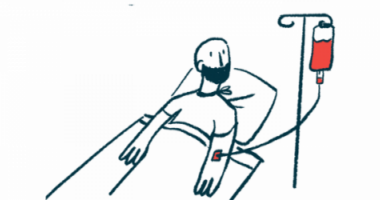New analysis suggests more benefit from Nexviazyme than Lumizyme
The two treatments were compared in respiratory, exercise assessments

People with late-onset Pompe disease (LOPD) treated with Nexviazyme (avalglucosidase alfa) may be more than twice as likely to benefit from treatment than those on Lumizyme (alglucosidase alfa), a new analysis of data from the Phase 3 COMET trial suggests.
The analysis employed a method called the win ratio that enables the joint assessment of multiple clinical trial endpoints, in this case respiratory function and exercise capacity, to determine a treatment’s overall effect.
“This win ratio analysis provides a rationale for combining new insights with existing evidence from the COMET study and may lead clinical decision-makers to prefer [Nexviazyme] over [Lumizyme] when initiating enzyme replacement therapy,” the researchers wrote in “Applying the win ratio method in clinical trials of orphan drugs: an analysis of data from the COMET trial of avalglucosidase alfa in patients with late-onset Pompe disease,” which was published in the Orphanet Journal of Rare Diseases.
Rare diseases like Pompe disease often have complex effects on multiple bodily systems. In clinical trials, several different endpoints might be used to assess an investigational therapy’s benefits across these various disease domains. But analyzing each domain on its own limits being able to adequately capture a treatment’s overall impact. Plus, clinical variability and small sample sizes in rare disease trials make it difficult to detect a meaningful treatment effect in individual domains.
This means better ways to jointly analyze multiple clinical trial endpoints are needed, according to the authors, who propose the win ratio method, which has been employed in cardiovascular disease clinical trials.
How is a ‘win ratio’ produced?
The technique involves individually comparing every person on an investigational treatment to every person on a comparator treatment (e.g. placebo) to see if they had a better (win), worse (lose), or the same (tie) outcome for what is considered the most important clinical trial endpoint.
If the pair tie, they are then similarly compared for the second most important endpoint, and so on. At the end, all wins and losses are tallied to produce a so-called “win ratio” for the treatment, thought to reflect the odds it will produce a meaningful benefit over the comparator.
“By considering multiple endpoints jointly, the win ratio approach produces a more comprehensive assessment of the benefits of a treatment,” said the researchers who here applied the method to data from the completed COMET Phase 3 trial (NCT02782741), which compared the safety and efficacy profile of the second-generation enzyme replacement therapy (ERT) Nexviazyme to Lumizyme, its predecessor, in 100 people with LOPD.
COMET’s main goal was to evaluate changes in respiratory function, as assessed by the forced vital capacity (FVC) test, after nearly a year of treatment. A key secondary goal was to assess changes in exercise capacity, as assessed by the six-minute walk test (6MWT).
Top-line trial analyses, which backed Nexviazyme’s approval, found the second-generation ERT was not inferior to, or just as good as Lumizyme, in these outcomes, but not necessarily superior to it.
To apply the win ratio, each participant’s FVC and 6MWT response after a year of treatment was categorized as a meaningful improvement, no meaningful change, or a meaningful decline, with thresholds determined based on previous Pompe studies.
Each patient in the Nexviazyme group (51) was compared to each patient in the Lumizyme arm (49) for outcomes in the FVC test.
A win occurred when a Nexviazyme participant achieved a better response category than their Lumizyme-treated counterpart. Of 2,499 pairs of patients, 923 pairings yielded a win, while 417 were considered a loss, and 1,159 were deemed a tie.
The 1,159 pairings considered a tie were then compared on the 6MWT, yielding 314 wins, 106 losses, and 739 ties.
Nexviazyme outperforms Lumizyme in analysis
Altogether, there were 1,237 wins for Nexviazyme and 523 losses — a win ratio of 2.37. When the order of comparisons was reversed, meaning patients were compared first on 6MWT performance, then FVC as a tie breaker, the win ratio was similar at 2.02.
In either case, this ratio reflects that a person taking Nexviazyme is more than twice as likely to benefit than one on Lumizyme, with statistical significance. Nexviazyme was similarly favored when patients were divided by sex and baseline lung function.
In addition to offering insights into Nexviazyme’s possible clinical benefits, the researchers say the findings showcase the value of the win ratio for analyzing clinical trials.
“This re-analysis of outcome data from the COMET trial highlights the win ratio as an analytic approach that can provide meaningful insight on treatment benefits across various disease domains in clinical trials of rare diseases where multiple endpoints are evaluated,” they said.
The study was funded by Sanofi, which markets Nexviazyme and Lumizyme.







